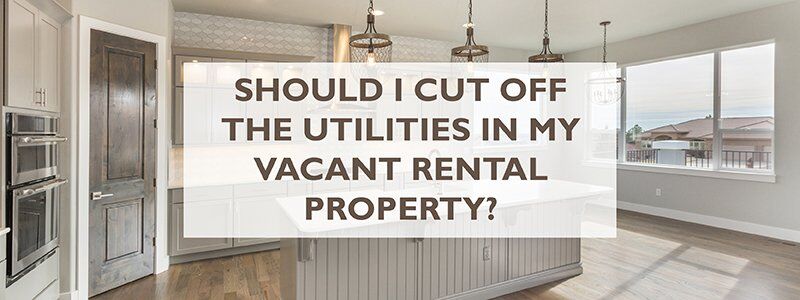Utilities in a Vacant Rental? Keep ‘em On!
“Should I cut off the utilities in my vacant rental property?”
My answer? No way.
It’s one of the first questions my homeowner clients ask me—and my emphatic answer often surprises them. After all, none of us is eager to have higher bills—and my maintenance staff and I pride ourselves on looking for ways to conserve energy and lower costs for clients.
Yet, at the same time, I know it’s the best advice. Don’t turn off the utilities in a vacant rental. It’s a shortsighted solution—and one that can be enormously wasteful of time, money, labor, and fuel in the long run. On the other hand, keeping everything running as though the house were occupied isn’t the best answer either.
Keep your future tenants in mind.
The most successful landlords know how to think beyond short-term costs to put themselves in a tenant’s shoes. Remember that when prospective tenants walk through the door, the very first thing they do is to imagine themselves living in the home. It’s only natural to want to turn lights on, run faucets, and generally feel comfortable just being in the house.
Especially if you’re looking for tenants in the coldest part of the year, your best bet is to welcome a prospective renter into a setting that feels cozy—or at the very least, doesn’t require donning a hat and mittens. Spending a little extra money on creating that welcoming setting is ultimately the most cost-effective way for a landlord to prevent extended vacancies. And good communication between leasing agent and property manager will guarantee that the house can be checked and made ready a couple of hours before the showing—and then restored to an energy-saving mode afterward.
Which brings me to my next point.
Yes, you need all utilities on (not just electricity).
Sure, the temptation is great to leave only the electricity on; but 30 years of experience as a property manager has taught me that all utilities should remain in service for every vacant rental home. Keeping water running is just as critical as keeping the lights on. And for those property owners who fear possible water emergencies causing disaster in their vacant home, I remind them of this: Preventing most water emergencies (and burst pipes in winter) is as simple as turning the water off at the main valve. I recommend taping commode covers shut—and, as I mentioned above, turning water on temporarily for tenant showings.
Keep the AC running in summer—and winterize in fall.
Another big temptation for landlords looking to control utility costs is to set the thermostat around 80 degrees during the hottest part of the summer—and then around 60 degrees in the winter. While those settings will lower the utility bills for your rental, they will also guarantee the house is pretty uncomfortable for anyone who walks in during a heat wave or a cold snap. If it’s the summer season, the air conditioning should be set no higher than 75 degrees. If it’s the winter season, the heat should be set no lower than 65 degrees.
Having said this, I’ll add that vacant homes should definitely be winterized prior to the cold season. Draining hose bibs where residual water lies—as well as ensuring water is turned off at the main valve—is really all that’s needed to prevent pipes from bursting in a deep freeze.
Can I deduct Utilities for Rental Properties?
Landlords, rejoice. Vacant single-family rental properties can claim certain utility-related tax deductions, such as electricity or gas needed to maintain the property during vacancy periods. You can still deduct utility costs during vacancy periods as long as the property was actively marketed for rent and you keep accurate records. Remember, as a landlord, you can minimize your taxable income by capitalizing on the various tax deductions that are accessible to you.
Make sure to provide evidence of availability for rent, such as online listings or advertisements, and consult with a real estate tax professional to maximize your benefits.
Remember, not all utility expenses are deductible in every situation, so be sure to understand the restrictions based on factors like personal use or landlord residency.
For even more ways to minimize taxable income from rental properties, consider claiming depreciation on assets or taking advantage of special tax credits offered by local governments or energy companies.
How to Report Utility Expenses on Form 1040
Reporting rental property income and expenses on Form 1040 is a must-do when filing taxes, and keeping track of utility deductions can save you big bucks.
- Gather relevant documents: Collect receipts, invoices, and other documentation for utilities paid by you as the landlord.
- Determine deductible utility costs: Calculate the total amount spent on utilities for each rental property during the tax year.
- Complete Schedule E (Supplemental Income and Loss): Fill out this form with details about your rental properties’ incomes/expenses before transferring totals to Form 1040.
Schedule E – Supplemental Income and Loss PDF Link
As a landlord, don’t miss out on valuable tax benefits by overlooking rental utility deductions. If you are ready to rent your home, feel free to take advantage of our exclusive FREE Rental Market Analysis. Finally, don’t forget to connect with us on social media! Follow us on Facebook, Twitter, LinkedIn, Instagram, and Pinterest for tips, ideas and updates.


